HP ZR2740w - High Resolution IPS that Doesn't Break the Bank
by Chris Heinonen on March 16, 2012 1:15 AM ESTColor Quality
Straight out of the box, the color accuracy of the HP leaves a disappointing taste. The average dE is close to 9, and the grayscale is well up there, almost entirely in the double digits. Due to the lack of an OSD or other controls, there isn’t any other color mode you can select, such as sRGB or 6500K, to try to improve these results without calibration. If you purchase the ZR2740w and cannot calibrate it, this is the performance you can expect with no way to improve upon it at all.

Of course, since many people purchasing this display will be calibrating it, we want to see how well it performs after a calibration. Using ColorEyes Display Pro on a MacBook Air, I set the targets to my usual preferences: 200 nits of light output, a D65 white point, gamma of 2.2, and minimum black level. The calibration was done with an i1Pro spectrometer that is NIST certified to have a maximum error of 1.0 dE and an average error of 0.4. Using these settings, we get a much better result out of the HP.
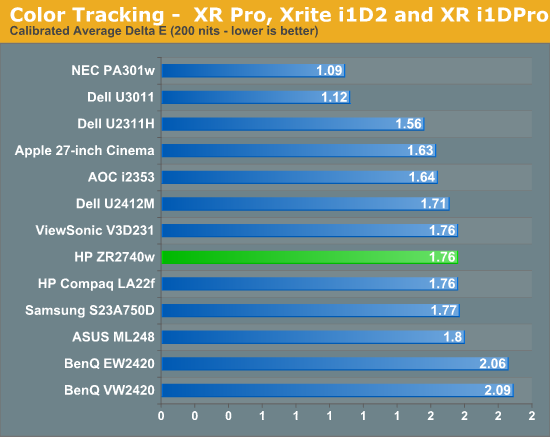
Here we can see that our dE has dropped down to an average of 1.76 which is pretty good. The errors, as usual, are in shades of blue at the edge of the sRGB colorspace, and that grayscale that was horrible is now down to an error of under 1 for almost the entire range. Again I wanted to look at the median color error and see how much this average error is being skewed by the blue results.

Our median color error is a dE of 1.2, which is quite good. There are a lot of panels that do worse than that, and not many that can do much better at all. The only way to really get an error much better than this is to find a panel that uses the full AdobeRGB colorspace, so those shades of blue will be able to be rendered correctly. As a high resolution 27” monitor is likely to be targeted towards professionals, including those doing print work, the 100 nits results were even more important this time than usual.
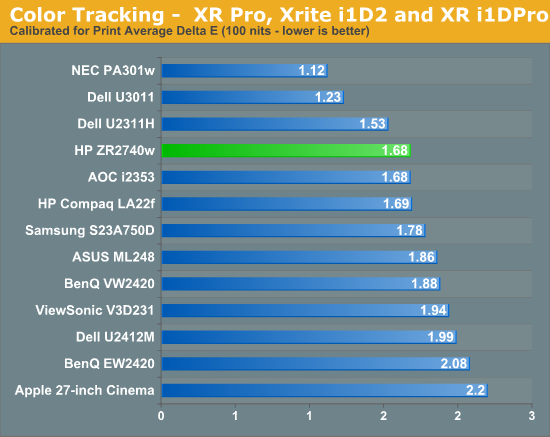
The dE results are very similar to those with 200 nits of light output, down to the grayscale having similar errors across the spectrum. The worst grayscale patch is the dark gray, which is the hardest for the i1Pro to read accurately, but until I have a better calibration program that allows for meter profiling, it’s the best result I’ll be able to get for you. Overall the calibrated results for the HP are good, but with no OSD at all the only way to get even close to these is with a calibration package, since you can’t even copy settings from another display and hope they look OK on your monitor. You could always try copying a color profile from someone else with the same monitor, but even then you're likely to get significant errors as there's plenty of variance between otherwise "identical" panels.


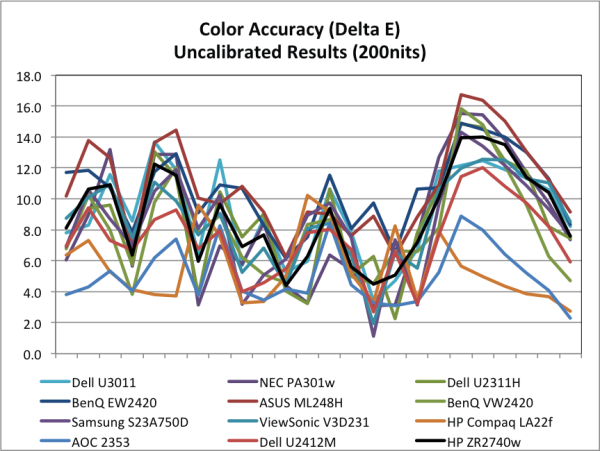
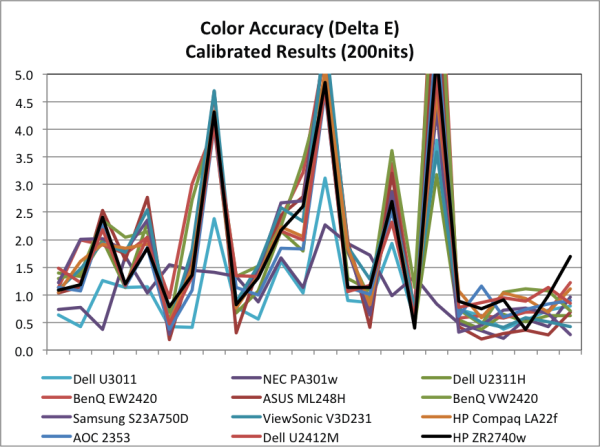
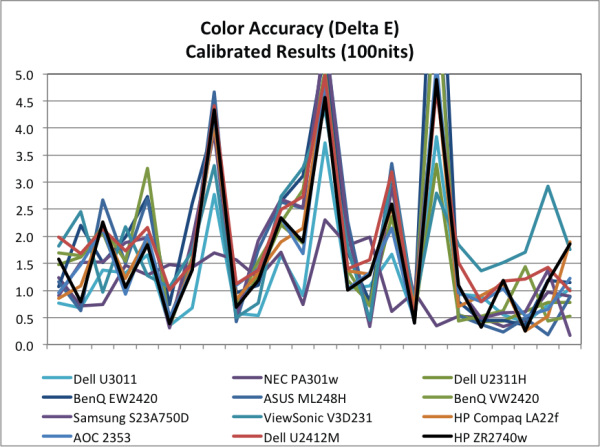








119 Comments
View All Comments
xenol - Friday, March 16, 2012 - link
Was it wrong of me to think "doesn't break the bank" immediately meant <$500?PrinceGaz - Friday, March 16, 2012 - link
1. The built-in resolution scaling.How does it compare with the scaling available in (for instance) nVidia graphics-card when driving digital displays over a DVI connection. Does 1920x1080 sent to the monitor look the same whether the scaling is done by the monitor or the graphics-card?
What about non-16:9 aspect-ratios; what happens if you send it a 1600x1200 signal? Is the aspect-ratio kept at 4:3 (so black bars down the sides) or does it stretch it to fill the whole screen? Can it handle 1280x1024, 1280x960, 1152x864, and also 640x480, and are they all displayed 4:3 or stretched to fill the 16:9 display?
2. Monitor calibration
Is the hardware/software for this available to hire, given it is quite expensive, is a one-off process for any monitor, and monitors tend to last for years?
arjuna1 - Friday, March 16, 2012 - link
At a $700 price point?? a little early April's fool joke, huh?cheinonen - Friday, March 16, 2012 - link
Just to address a lot of the comments at once, pricing on anything is relative. If all you can afford for a monitor is $300, then no matter how good a $700 monitor is, its going to cost too much. However, when all the existing 2560x1440 IPS displays (I'm not counting things that aren't sold in the USA) list for $1,000 or over, and someone comes in at $700, that is breaking the bank, relatively speaking. Any IPS/VA panel of this size, with this resolution, is going to be expensive at this point, but having one come out at $700 is a good move in the right direction.bji - Friday, March 16, 2012 - link
Your post is accurate, except that I think you misunderstood the meaning of the phrase "breaking the bank". It means "costing too much", not "breaking a price barrier" which is what you seem to think it means.Death666Angel - Friday, March 16, 2012 - link
But cost is surely always related to performance, is it not? By your argument, paying $15 for a steak would be breaking the bank, because I can get a hamburger for $5. However, the OP and I would say that, because steaks normally cost $25, the price of this steak is pretty reasonable.Therefore I say, "breaking the bank" always has to be a relative statement, because otherwise you couldn't buy anything about 500$ without "breaking the bank", which makes the saying useless.
Owls - Friday, March 16, 2012 - link
I have the HP ZR30W which I got last year and it's a phenomenal monitor. Well worth the $1k pricetag if you can swing it and I'm glad this one doesn't disappoint either.AnnonymousCoward - Friday, March 16, 2012 - link
Does Delta E improve after software calibration, such as the nvidia color optimization wizard, or Calibrize? These tools are excellent, and I use them on every computer I use. I'm just curious if they lower Delta E.sellco2000 - Saturday, March 17, 2012 - link
I'm surprised no one mentioned the anti-glare on this monitor. I have a ZR2740 (and absolutely love it), but the anti-glare coating made text fuzzy for me. Maybe I was used to the non-IPS and larger pixel pitch of my prior monitors. I had to add an aftermarket anti-reflective sheet to it to make text sharp again. I feel like the choice of such an aggressive anti-glare was an almost deal-breaking flaw.As far as the review went, I thought it was spot on. The color profiles matched pretty well with what I was able to get with my "I one color display 2" device. I think the simplicity is a huge advantage with this monitor (no speakers, no OSD, etc).
pmeinl - Saturday, March 17, 2012 - link
For me the aggressive anti-glare coating of all current IPS panels I have seen makes them unusable for text work (like programming).I just bought a Samsung S27A850D (2560x1440, 730€ in Germany) which has a subtle anti-glare coating that does not cause the sparkle effect.
See http://hardforum.com/showthread.php?t=1660116